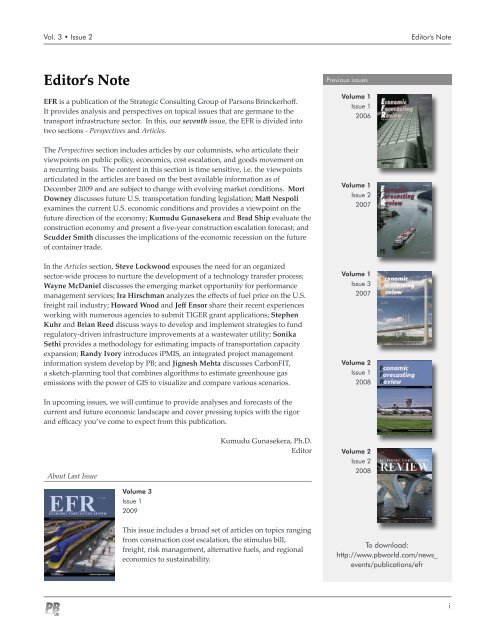ECONOMIC FORECASTING REVIEW - Parsons Brinckerhoff
ECONOMIC FORECASTING REVIEW - Parsons Brinckerhoff
ECONOMIC FORECASTING REVIEW - Parsons Brinckerhoff
Create successful ePaper yourself
Turn your PDF publications into a flip-book with our unique Google optimized e-Paper software.
a publication of the Strategic Consulting Group of <strong>Parsons</strong> <strong>Brinckerhoff</strong><br />
Volume 3 • Issue 1<br />
May 2009<br />
California High-Speed Rail<br />
Vol. 3 • Issue 2<br />
Editor's Note<br />
Editor’s Note<br />
EFR is a publication of the Strategic Consulting Group of <strong>Parsons</strong> <strong>Brinckerhoff</strong>.<br />
It provides analysis and perspectives on topical issues that are germane to the<br />
transport infrastructure sector. In this, our seventh issue, the EFR is divided into<br />
two sections - Perspectives and Articles.<br />
Previous issues<br />
Volume 1<br />
Issue 1<br />
2006<br />
The Perspectives section includes articles by our columnists, who articulate their<br />
viewpoints on public policy, economics, cost escalation, and goods movement on<br />
a recurring basis. The content in this section is time sensitive, i.e. the viewpoints<br />
articulated in the articles are based on the best available information as of<br />
December 2009 and are subject to change with evolving market conditions. Mort<br />
Downey discusses future U.S. transportation funding legislation; Matt Nespoli<br />
examines the current U.S. economic conditions and provides a viewpoint on the<br />
future direction of the economy; Kumudu Gunasekera and Brad Ship evaluate the<br />
construction economy and present a five-year construction escalation forecast; and<br />
Scudder Smith discusses the implications of the economic recession on the future<br />
of container trade.<br />
Volume 1<br />
Issue 2<br />
2007<br />
In the Articles section, Steve Lockwood espouses the need for an organized<br />
sector-wide process to nurture the development of a technology transfer process;<br />
Wayne McDaniel discusses the emerging market opportunity for performance<br />
management services; Ira Hirschman analyzes the effects of fuel price on the U.S.<br />
freight rail industry; Howard Wood and Jeff Ensor share their recent experiences<br />
working with numerous agencies to submit TIGER grant applications; Stephen<br />
Kuhr and Brian Reed discuss ways to develop and implement strategies to fund<br />
regulatory-driven infrastructure improvements at a wastewater utility; Sonika<br />
Sethi provides a methodology for estimating impacts of transportation capacity<br />
expansion; Randy Ivory introduces iPMIS, an integrated project management<br />
information system develop by PB; and Jignesh Mehta discusses CarbonFIT,<br />
a sketch-planning tool that combines algorithms to estimate greenhouse gas<br />
emissions with the power of GIS to visualize and compare various scenarios.<br />
Volume 1<br />
Issue 3<br />
2007<br />
Volume 2<br />
Issue 1<br />
2008<br />
In upcoming issues, we will continue to provide analyses and forecasts of the<br />
current and future economic landscape and cover pressing topics with the rigor<br />
and efficacy you’ve come to expect from this publication.<br />
About Last Issue<br />
Kumudu Gunasekera, Ph.D.<br />
Editor<br />
Volume 2<br />
Issue 2<br />
2008<br />
EFR<br />
<strong>ECONOMIC</strong> <strong>FORECASTING</strong> <strong>REVIEW</strong><br />
Volume 3<br />
Issue 1<br />
2009<br />
This issue includes a broad set of articles on topics ranging<br />
from construction cost escalation, the stimulus bill,<br />
freight, risk management, alternative fuels, and regional<br />
economics to sustainability.<br />
To download:<br />
http://www.pbworld.com/news_<br />
events/publications/efr<br />
i
















